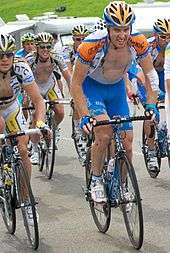Autobus (cycling)

The autobus or the gruppetto is in bicycling terminology the name given to the group of cyclists in a road cycling race who form a large group behind the leading peloton.
The autobus forms on mountain stages when non-climbers fall off the back of the peloton during the climb. Gradually some riders fall off the back of the peloton and form a large group at the end of the race. These riders are generally sprinters or domestiques unconcerned about their finishing positions in the mountain stages. Their primary concern is beating the elimination time to ensure their survival in a multi-stage race such as the Tour de France.
If the autobus arrives outside the elimination time, the organisers may extend the elimination time if the autobus is larger than 20% of the riders. However if a rider is dropped from the autobus in this situation they will almost certainly be eliminated unless they have suffered an accident, in which case they may be exempted. The elimination time varies depending on the organisers; in the Tour de France there are differing coefficients depending on the difficulty of the stage. These coefficients are a percentage of the stage winner's time.[1]
Due to the common interest in survival, the mood in the autobus has a greater sense of camaraderie than in the main peloton. Riders often assist one another with food and drinks despite riding for separate teams.[1][2] It is sometimes referred to as "the laughing group".
References
- 1 2 Haake, Bjorn "Latest Cycling News for July 24, 2007" cyclingnews.com 24 July 2007. Retrieved 21 February 2010
- ↑ "In the Hurt Bag: Part Two". Bicycling.com. Retrieved 16 June 2014.
External links
 The dictionary definition of gruppetto at Wiktionary
The dictionary definition of gruppetto at Wiktionary